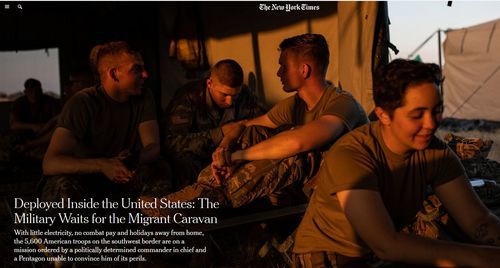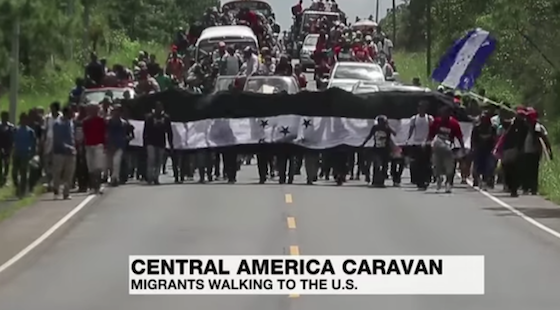
NEW YORK TIMES Expresses Dismay Regarding US Soldiers On The Border
11/13/2018
Sunday’s New York Times featured an extra-large photo of US troops preparing for duty on the US border:

As expected, the Times text is dismissive of the effort, but surely many Americans will appreciate our soldiers protecting this nation’s security rather than everywhere else on earth. For example, US troops have remained in South Korea since the end of the war in 1953, and today there are around 23,000 American soldiers there.
Of course the region is a potential flash point for trouble, but it’s not alone in getting US muscle: a May 3 Times editorial noted, “In at least 14 countries, American troops are fighting extremist groups that are professed enemies of the United States…”
Back to our border, the Times is particularly snooty in this case, putting the word “invasion” in quotes, like only an idiot would think in that way:
The midterm elections are over, along with President Donald Trump’s rafter-shaking rallies warning that an approaching migrant caravan of Central Americans amounts to a foreign “invasion” that warrants deploying up to 15,000 active-duty military troops to the border states of Texas, Arizona and California.
But what else would you call it when thousands of foreigners are marching this way with the stated intention of breaking into the US?
Below, invasive Hondurans carry their national flag as they advance toward the United States.

The Times article was reprinted in the Santa Fe New Mexican:
Troops awaiting caravan, likely past Thanksgiving, New York Times, November 10, 2018
BASE CAMP DONNA, Texas — Sgt. 1st Class Daniel Micek, a platoon sergeant with the 89th Military Police Brigade, tore open the brown packaging of his MRE on Thursday.
It was a chicken and noodle dish, one of the more sought-after rations because it comes with Skittles. But from the cot outside his platoon’s tent at the Army’s latest forward operating base, Micek could almost see the bright orange and white roof of Whataburger, a fast-food utopia 8 miles away but off limits under current Army rules. The desert tan flatbed trucks at the base are for hauling concertina wire, not food runs.
Such is life on the latest front where U.S. soldiers are deployed. The midterm elections are over, along with President Donald Trump’s rafter-shaking rallies warning that an approaching migrant caravan of Central Americans amounts to a foreign “invasion” that warrants deploying up to 15,000 active-duty military troops to the border states of Texas, Arizona and California.
But the 5,600 U.S. troops who rushed to the brown, dry scrub along the southern border are still going through the motions of an elaborate mission that appeared to be set into action by a commander in chief determined to get his supporters to the polls, and a Pentagon leadership unable to convince him of its perils.
Instead of football with their families on this Veterans Day weekend, soldiers with the 19th Engineer Battalion, fresh from Fort Knox, Ky., were painstakingly webbing concertina wire on the banks of the Rio Grande, just beneath the McAllen-Hidalgo-Reynosa International Bridge.
Nearby, troops from Joint Base Lewis-McChord in Washington state were making sure a sick call tent was properly set up next to their aid station. And a few miles away, Staff Sgt. Juan Mendoza was directing traffic as his engineer support company from Fort Bragg, N.C., unloaded military vehicles.
Come Thanksgiving, they most likely will still be here.
Two thousand miles away, at the Pentagon, officials privately derided the deployment as an expensive waste of time and resources, and a morale killer to boot.
Leading up to the midterm vote last week, the military announced that the border mission would be called Operation Faithful Patriot. But Defense Secretary Jim Mattis on Election Day told officials to drop the name, and the Pentagon sent out a terse news release a day later saying the operation was now simply to be known as border support. The term “faithful patriot,” officials said, had political overtones.
A final cost estimate of the deployment has not been made available. But Defense Department budget officials fret that if the number of troops sent to the border does reach 15,000, the price tag could hit $200 million, with no specific budget allocation from which to draw. (Continues)
Note the paragraph above: when a liberal paper shows concern about the cost of a government program, there’s generally something else going on behind its opinion.
